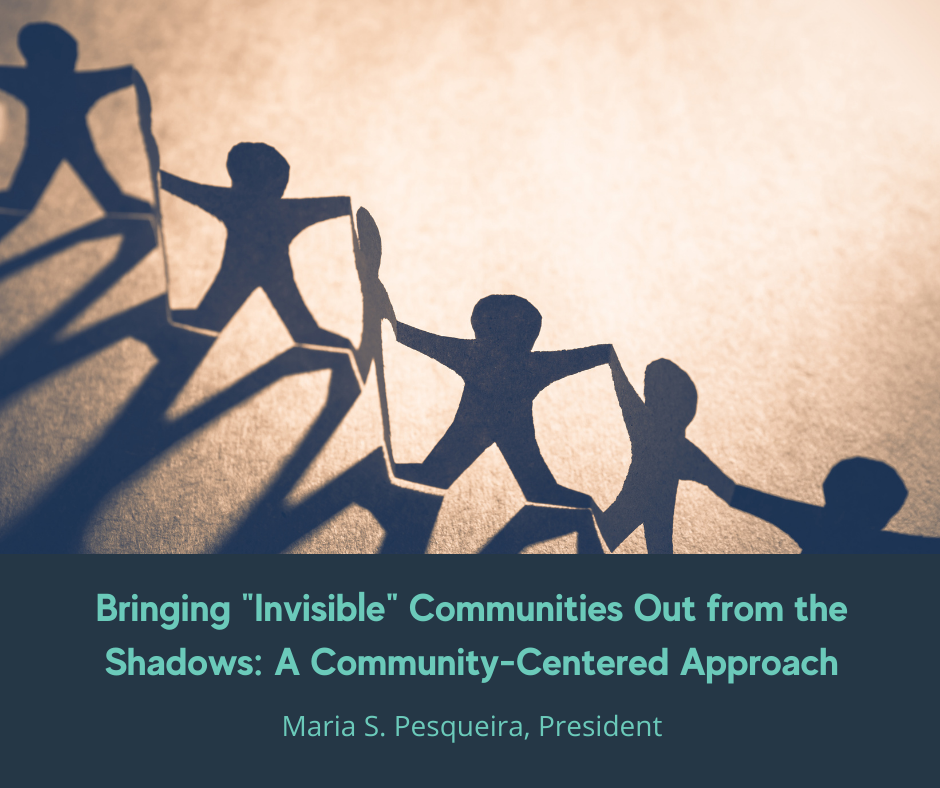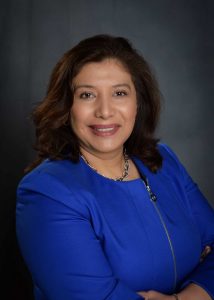
26 Jan Bringing Invisible Communities Out from the Shadows: A Community-Centered Approach
Share This ArticleThis post originally appeared in the Grantmakers in Health’s “Views from the Field” in the January 2021 Bulletin.
COVID-19 has not been an equal opportunity pandemic. It has impacted Latinx, Black and Indigenous communities, immigrants, older adults, and the uninsured more profoundly than the general population. At the start of the public health crisis and several weeks after, the impact on these communities remained invisible with devastating health consequences. While it is a challenge that cannot be solved by philanthropy alone, it has become clear that the sector must work harder to know and respond to communities whose needs are hidden for many reasons, especially as the pandemic rages on and we work towards recovery.
While it is a challenge that cannot be solved by philanthropy alone, it has become clear that the sector must work harder to know and respond to communities whose needs are hidden for many reasons, especially as the pandemic rages on and we work towards recovery.
As a health conversion foundation that serves parts of Chicago and its western suburbs, the Healthy Communities Foundation invests in communities that have not typically attracted substantial health and human service investment from philanthropy or government before the pandemic. Our service area has one of the largest Latinx communities in the country, one of the largest metropolitan native communities in the country, a Black population that is quickly shifting to the western suburbs, the largest Palestinian community outside of Palestine, and a fast-growing Asian population.
Early in the pandemic, we heard from our grantees about the mushrooming impact of COVID-19 on the Latinx population long before it was recognized publicly. We used this information to bring significant resources to these communities across several priority areas by playing a leadership role in local funding collaboratives. Along with our own commitment, we leveraged more than $8 million of additional investment to support emergency services, direct assistance, and recovery in our region. As has been our practice and commitment since our foundation’s journey began, and in the early weeks of the pandemic, we listened and partnered with communities to guide our actions, especially those that have been historically invisible in public health data and policies.
As has been our practice and commitment since our foundation’s journey began, and in the early weeks of the pandemic, we listened and partnered with communities to guide our actions, especially those that have been historically invisible in public health data and policies.
We want to offer some of our actions and reflection points to inspire and inform what other health funders can do during this time of crisis and beyond:
Informed the local philanthropic community of the urgent needs of hard-hit communities in both city and suburban areas.
It was immediately apparent that the pandemic was a crisis not isolated to one geography. Quickly, foundation leaders crafted rapid response plans, pooled their resources, and solicited donations. We raised the visibility of our service region—part city, part suburbs—in conversations with funder peers as it includes communities among the hardest hit by COVID-19 in our county and state. We realized that most rapid response funding stayed within the city limits and pressing needs for some city neighborhoods were not being met. Because foundations in the Chicago Metropolitan area have historically focused most funding in certain parts of Chicago, we raised awareness of what was happening on the South and Southwest sides of Chicago and the western suburbs to allocate more rapid response funds to these areas.
Relied on both quantitative and hyper-local qualitative data to inform strategies.
We worked closely with an outside demographer during our strategic planning process in 2017 to map out population changes and the diverse health outcomes of one community to the next, making apparent what was not readily visible by looking at current health data alone. During the initial stages of the pandemic, this knowledge, and that from staff who live in the region, fueled our strategy to solicit input from grantee and community partners proactively. This action helped us understand what was happening at a hyper-local level, which signaled the dramatic COVID-19 impact on Latinx communities in our region before it began to appear in public health data.
“The enormity of the crisis has pulled back the veil and exposed health inequities in areas that are frequently forgotten by philanthropic and government funding.”
Partnered with local government and funder peers to close social service gaps and guide others to use an equity lens in program development.
In the past couple of years, we have worked with two township mental health boards, Community Mental Health Board of Oak Park Township and River Forest Township, and a health funder peer, Community Memorial Foundation, to build a digital social care directory, The HUB, that serves community residents and community-based organizations. This directory connects communities to needed programs, helps organizations manage referrals, and, long-term, will highlight existing gaps in the suburban social service infrastructure. We also helped guide the city and county public health departments as they developed their contact tracing programs to ensure an equity lens was applied to the process. It is essential to address the need for culturally competent public health workers with community-level knowledge to effectively reach Black and Latinx communities in our region for contact tracing and vaccine distribution.
Supported community health providers to move into underserved communities.
In partnership with the Community Memorial Foundation, we initiated a community health worker pilot in the western suburbs in 2018 to bridge the gap between health and social service providers and community residents. This pilot has improved the cultural competence of service delivery in areas where residents lack awareness of local health and social resources, which has been crucial this past year. We have also supported a grantee partner, Inner-Muslim Action Network, who recently was named a federally qualified health center, as they built a model of integrated health and social services in the underserved southern part of our region. This area includes parts of the South Side of Chicago and Southwest suburbs that have seen an influx of new Latinx residents due to gentrification in nearby areas and a growing number of Arab and Black communities who need and deserve comprehensive and culturally competent health care.
Aside from bringing together current allies, new partners, and access to more significant resources, the enormity of the crisis has pulled back the veil and exposed health inequities in areas that are frequently forgotten by philanthropic and government funding. While this crisis has illuminated the deficiencies in our current health care and human service infrastructure, it creates an opportunity for us to reimagine what health can be. These inequities are now in full display—we must take action and address them.
These inequities are now in full display—we must take action and address them.
During this time, we can apply lessons learned more broadly in how we target our dollars as health funders and the roles that we play in community partnerships. In the weeks and months ahead, decisions will be made that are critical to the lives of individuals and families—testing, vaccinations, in-person learning, resource allocation. We need to lift up the communities that fly under the radar, listen to community voices even when the data might not account for them, actively advocate for equity when at influential tables, and be ready to use our philanthropic power in innovative and bold ways.
Maria del Socorro Pesqueira was appointed President of Healthy Communities Foundation in May 2017. As an award-winning visionary leader, she is a sought-after speaker addressing local, national, and hemispheric audiences on a wide variety of topics ranging from private/nonprofit partnerships, health disparities, immigration reform, women and family issues, violence prevention, and the future of philanthropy.


Sorry, the comment form is closed at this time.